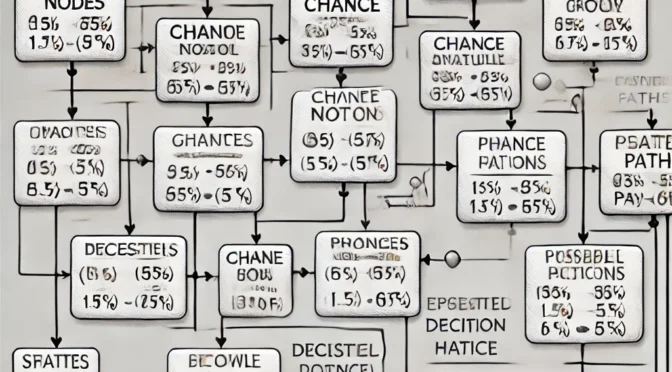Decision Analysis focuses on developing a structured approach to decision-making in situations involving uncertainty and risk. The chapter discusses various models and techniques that help managers and decision-makers choose the best course of action when faced with different possible outcomes.
Key Concepts
1. Decision-Making Under Uncertainty and Risk
- Decision-making can occur under certainty, uncertainty, or risk.
- Certainty implies that the outcomes of all decisions are known.
- Uncertainty means the decision-maker does not know the probabilities of various outcomes.
- Risk involves situations where probabilities can be assigned to the possible outcomes of decisions.
2. Decision-Making Environments
- Under Certainty: The decision-maker knows with certainty the outcome of every decision. Here, the optimal decision is chosen based on maximizing profit or minimizing cost.
- Under Uncertainty: The decision-maker lacks complete information about the environment or outcomes. Several criteria are used to make decisions:
- Maximin Criterion: Focuses on maximizing the minimum payoff. Suitable for pessimistic decision-makers.
- Maximax Criterion: Seeks to maximize the maximum payoff. Suitable for optimists.
- Minimax Regret Criterion: Involves minimizing the maximum regret. Regret is the difference between the payoff from the best decision and all other decision alternatives.
- Hurwicz Criterion: A weighted average of the best and worst payoffs. It introduces a coefficient of optimism (alpha) to reflect the decision-maker’s attitude toward risk.
- Equal Likelihood (Laplace) Criterion: Assumes all states of nature are equally likely and chooses the decision with the highest average payoff.
3. Decision Trees
- Decision Trees are graphical representations of decision problems. They consist of decision nodes (square nodes), chance nodes (circle nodes), and branches representing decisions or possible events.
- A decision tree helps visualize and solve problems by breaking them down into sequential decisions and possible events.
4. Expected Value and Expected Utility
- Expected Value (EV): A method used to evaluate risky decisions by calculating the average payoff of each decision alternative based on the probabilities of different states of nature. The formula is:
$$
EV = \sum (P_i \times V_i)
$$
where (P_i) is the probability of state (i) and (V_i) is the value or payoff associated with state (i).
- Expected Utility (EU): Some decision-makers use a utility function to reflect their preferences and attitudes toward risk. Expected utility is the sum of the utilities associated with each possible outcome, weighted by the probability of that outcome. It is calculated similarly to expected value but uses utility values instead of payoffs.
5. Value of Perfect Information
- The Value of Perfect Information (VPI) is the amount a decision-maker would be willing to pay for perfect information about the state of nature. It represents the maximum amount one should pay to gain perfect knowledge of which state of nature will occur.
- The VPI can be calculated as the difference between the expected value with perfect information (EVwPI) and the expected value without perfect information (EVwoPI):
$$
VPI = EV_{wPI} – EV_{woPI}
$$
6. Sensitivity Analysis
- Sensitivity Analysis examines how the outcomes of a decision model change with variations in input parameters, such as probabilities or payoffs. It helps assess the robustness of the optimal decision and understand the impact of uncertainty in the decision environment.
7. Bayesian Analysis
- Bayesian Analysis involves using Bayesian probability to update the probability estimates for different states of nature as new information becomes available. This approach is particularly useful when decisions are made sequentially, and additional information can be gathered to refine future decisions.
8. Utility Theory
- Utility Theory addresses the preferences of decision-makers who are risk-averse, risk-neutral, or risk-seeking. It introduces the concept of a utility function that quantifies the decision-maker’s satisfaction or preference for different outcomes. Decisions are made based on maximizing expected utility rather than expected monetary value.
Example Problem
Consider a decision-maker who needs to choose between three investment alternatives under uncertainty. The payoffs (in thousands of dollars) associated with each investment depend on three possible economic conditions: recession, stable, and growth. The decision table is as follows:
| Decision | Recession ($P_1 = 0.3$) | Stable ($P_2 = 0.4$) | Growth ($P_3 = 0.3$) |
|---|---|---|---|
| Investment A | 30 | 50 | 80 |
| Investment B | 40 | 60 | 70 |
| Investment C | 50 | 70 | 40 |
To find the Expected Value (EV) of each investment:
[
EV_A = (0.3 \times 30) + (0.4 \times 50) + (0.3 \times 80) = 9 + 20 + 24 = 53
]
[
EV_B = (0.3 \times 40) + (0.4 \times 60) + (0.3 \times 70) = 12 + 24 + 21 = 57
]
[
EV_C = (0.3 \times 50) + (0.4 \times 70) + (0.3 \times 40) = 15 + 28 + 12 = 55
]
Based on the expected values, Investment B would be the optimal decision with the highest expected payoff of 57.
Conclusion
Chapter 8 provides a comprehensive overview of decision analysis techniques and tools that help in making informed decisions under uncertainty and risk. It covers various criteria, decision trees, sensitivity analysis, Bayesian analysis, and utility theory to equip decision-makers with a structured approach to navigating complex decision environments.
